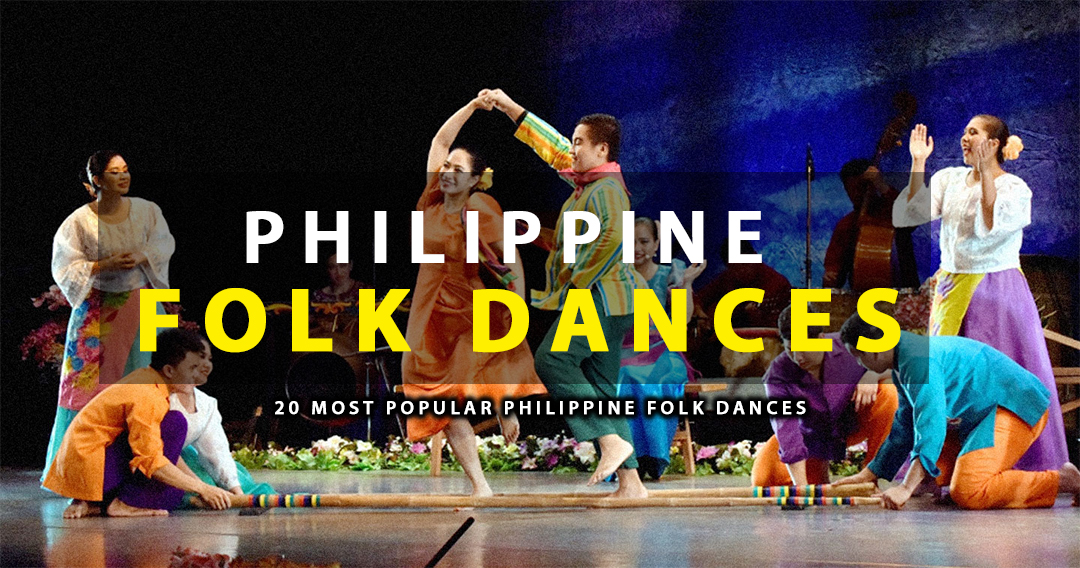
The Philippines, with its rich history and cultural diversity, boasts a wide array of traditional folk dances. These dances not only represent the vibrant and diverse culture of the country but also serve as a means to preserve and promote its heritage. Throughout the years, folk dances have been passed down from generation to generation, showcasing the Philippines’ distinct regional identities and traditions.
In this article, we will explore 20 of the most popular Philippine folk dances, categorized into three main groups based on the country’s three primary island groups: Luzon, Visayas, and Mindanao. Additionally, we will touch on the role of dance companies and schools in preserving these art forms, and highlight some of the most prominent Philippine folk dance festivals.
Most Popular Philippine Folk Dances
Luzon Folk Dances
1. Tinikling – This famous dance mimics the movements of the tikling bird, as dancers skillfully navigate between bamboo poles that are rhythmically tapped together.
2. Pandanggo sa Ilaw – A graceful dance that involves balancing oil lamps on the dancers’ heads and hands, symbolizing the fishermen’s celebration after a bountiful catch.
3. Binasuan – A lively dance where performers balance glasses filled with liquid on their heads and hands while executing intricate footwork.
4. Carinosa – Known as the national dance of the Philippines, Carinosa is a flirtatious courtship dance with participants using fans and handkerchiefs as props.
5. Maglalatik – A unique dance where male performers wear coconut shells on their bodies, creating rhythmic sounds as they depict a battle between Christians and Muslims.
6. Rigodon – Inspired by Spanish influence, Rigodon is an elegant dance typically performed at formal events and features complex patterns and turns.
7. La Jota Moncadena – A fusion of Spanish and Filipino dance styles, La Jota Moncadena incorporates castanets, bamboo poles, and intricate footwork.
Visayas Folk Dances
1. Kuratsa – A lively courtship dance from the Visayas region, characterized by playful and flirtatious movements between partners.
2. Sinulog – A vibrant and colorful dance that honors the Santo Niño, with participants dressed in elaborate costumes and performing energetic, synchronized movements.
3. Itik-itik – Inspired by the movements of ducks, this entertaining dance is characterized by quick, side-to-side steps and undulating arm movements.
4. Pantomina – Known as the “Dance of the Doves,” Pantomina simulates the courtship rituals of birds, with dancers imitating the male bird’s pursuit of his mate.
5. Aklanon – Hailing from the province of Aklan, this dance showcases the region’s unique culture and is often performed during local festivals.
Mindanao Folk Dances
1. Singkil – A mesmerizing dance that tells the story of a Maranao princess and her suitor, featuring precise footwork as dancers gracefully avoid clashing bamboo poles.
2. Kini Kini – Also known as the “Royal Walk,” Kini Kini showcases the elegance and poise of Maranao women as they gracefully move while balancing ornate fans or scarves.
3. Kapa Malong-Malong – A versatile dance that highlights the various ways a malong, a traditional tubular garment, can be worn and used.
4. Pangalay – A traditional dance of the Tausug people, characterized by intricate hand and arm movements, resembling the flow of water and the grace of birds in flight.
5. Sagayan – A warrior dance performed by the Maguindanao and Maranao tribes, Sagayan showcases fierce movements and brandishing of weapons, such as the kampilan (sword) and kalasag (shield).
6. Dugso – A ceremonial dance of the Manobo, Higaonon, and Talaandig tribes, Dugso is performed to please the deities, seeking protection and a bountiful harvest. The dance is characterized by rhythmic stomping and jumping.
The Role of Dance Companies and Schools
Several dance companies and schools in the Philippines are dedicated to preserving and promoting traditional folk dances. Some of the most notable institutions include:
- Bayanihan Dance Company
- Ramon Obusan Folkloric Group
- Philippine Baranggay Folk Dance Troupe
These organizations play a crucial role in ensuring that the artistry and cultural heritage of Philippine folk dances continue to thrive.
Prominent Philippine Folk Dance Festivals
Philippine folk dances are often showcased during local festivals, attracting both domestic and international tourists. Some of the most famous folk dance festivals in the country include:
- Kadayawan Festival – Held annually in Davao City, the Kadayawan Festival celebrates the city’s cultural heritage and showcases various traditional dances.
- Pahiyas Festival – This vibrant and colorful festival in Lucban, Quezon, features a variety of folk dances as part of the festivities to honor San Isidro Labrador, the patron saint of farmers.
- Panagbenga Festival – Also known as the “Baguio Flower Festival,” the Panagbenga Festival highlights the rich cultural heritage of the Cordillera region, including their traditional dances.
Frequently Asked Questions
1. What is the national dance of the Philippines?
Carinosa is considered the national dance of the Philippines. It is a flirtatious courtship dance that uses fans and handkerchiefs as props.
2. What are the three main island groups in the Philippines?
The three main island groups in the Philippines are Luzon, Visayas, and Mindanao.
3. What is the significance of Philippine folk dances?
Philippine folk dances are significant because they showcase the diverse culture and rich history of the country. They also play a vital role in preserving and promoting the country’s unique cultural heritage.
4. How can I learn Philippine folk dances?
You can learn Philippine folk dances by joining a local dance group or enrolling in a dance school that offers folk dance classes. You can also watch online tutorials or attend workshops and festivals where these dances are showcased.
5. What is the attire for Philippine folk dances?
The attire for Philippine folk dances varies depending on the specific dance and region. However, some common elements include the barong tagalog and baro’t saya for men and women, respectively, as well as the use of traditional accessories like fans, handkerchiefs, and malongs.
6. Are there any competitions or events dedicated to Philippine folk dances?
Yes, there are numerous competitions and events that celebrate Philippine folk dances. These events can be found at the regional and national level, with participants showcasing their skills and knowledge of traditional dances. Examples include the Sayaw Pinoy National Dance Competition and the annual Philippine Folk Dance Festival.
7. What is the role of dance companies and schools in preserving Philippine folk dances?
Dance companies and schools play a crucial role in preserving and promoting Philippine folk dances by teaching and showcasing these art forms to new generations. They help ensure that the traditional dances and the cultural heritage they represent continue to thrive in modern times.
Conclusion
Philippine folk dances are an integral part of the country’s cultural heritage. These dances showcase the diverse traditions and history of the Philippines, reflecting the unique blend of indigenous, Spanish, and other cultural influences. By learning and appreciating these captivating folk dances, we can help ensure that this rich cultural legacy continues to be celebrated and preserved for future generations.
Related Articles:
– Everything You Need to Know about Pamamanhikan
– Philippines Public Holidays 2024

